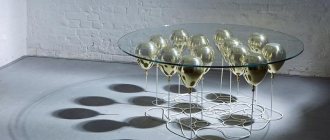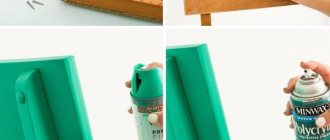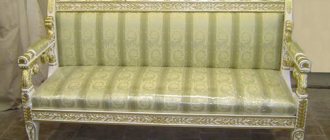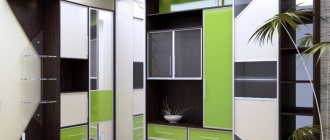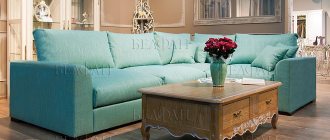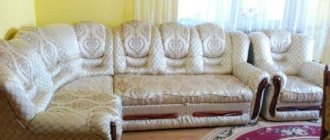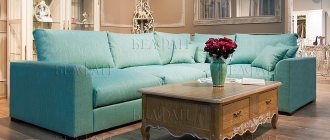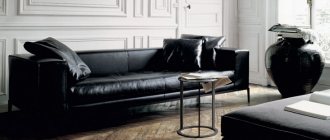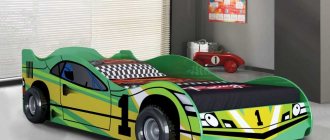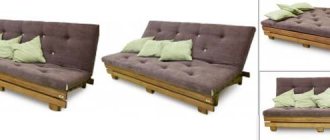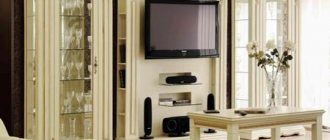2019-06-15
Author: Belfan
From this article you will learn:
- What styles of upholstered furniture exist and what are their features?
- What is characteristic of upholstered furniture in the loft style?
- What is the difference between upholstered furniture in Provence style?
- What materials are upholstered furniture made from?
- How to choose the right upholstered furniture
It is impossible to produce high-quality upholstered furniture without relying on historical continuity and diversity of style design solutions. When developing the concept of upholstered furniture, designers and manufacturers are guided by the fact that the best will be the one that repeats the character and temperament of its owner, while combining the best elements of world experience in the design of interior items. From our article you will learn about what styles of upholstered furniture there are, what features they have, as well as how to choose the right option for you.
Review of upholstered furniture styles: brief description
Styles of upholstered furniture (with photos and descriptions below) can be different, but there are only two main categories - modern and classic. Each is represented by several style solutions, among which you can choose an option that suits a specific interior.
Modern upholstered furniture.
- Modern.
Upholstered furniture in the Art Nouveau style is distinguished by asymmetrical and ornate lines, as well as a combination of materials (mainly wood and metal). Particular attention is paid to their texture. Such sofas and armchairs can look harmonious even in combination with individual pieces of modern furniture.
Upholstered furniture in a modern style: photo
Modern is different:
- Creative design - such furniture is not limited to one style and the framework of familiar forms.
- Convenience and functionality - since designers working with this style of furniture are not tied to the forms we are used to, they can experiment, giving interior items maximum convenience and comfort.
- A wide range of materials, from traditional (wood, leather) to new and high-tech.
- Bauhaus.
This style of upholstered furniture owes its name to its founder, who at the beginning of the last century came up with the idea of combining the functionality of furniture with practicality and simplicity. Such interior items are characterized by laconicism, clarity of form, functionality and at the same time a complete lack of decor.
The seats have a strictly quadrangular shape, the armrests are made in the form of triangles or cylinders. Sofas made in the Bauhaus style resemble a construction set. In them you will encounter a combination of the functionality of upholstered furniture and minimalism, Japanese modesty and the severity of the Celts.
The colors of the upholstery materials also support the general idea of the simplicity of the style of upholstered furniture: they are presented in a discreet cream or gray tone, always in demand in black or white.
- Eclectic.
This style of upholstered furniture mixes different trends - classic colors can be side by side with triangular armrests in the Bauhaus style, complemented by wooden or chrome legs borrowed from the pop style of the 1960s.
Two or three different style directions, combined in one style, allow all lovers of originality to create their own, truly original and unique interior.
- Minimalism.
The 20th century, a time of development of high technology, was characterized by a rapid change in styles of upholstered furniture. Interior design began to use invented functional solutions, clearly defined volumes and laconic forms. The development of the minimalist style began in the middle of the last century; it represented a unique form of purity, perfection and comfort. This direction is one of the most universal, but at the same time it has a strong personality.
Minimalism is not just a style, it is a certain philosophy of life. It is based on constructivism of the twenties of the last century and the “Zen” interiors of Japan. This design of space in most cases is characterized by the absence of decorative elements and ornaments.
This style is characterized by ideal proportions and new color solutions. At the same time, both items and color solutions are limited in the number of options. The lines of interior items are emphasized through color. Mainly white, gray and silver tones are used. Because of the ostentatious simplicity and asceticism, one gets the impression that minimalism is a cheap trend.
However, such a simple interior requires the use of objects and parts made using the latest technologies and expensive raw materials. The furniture is made from the best materials - frosted glass, steel, aluminum profiles, natural wood. Self-sufficient people with a rich inner world lean towards minimalism. Alongside this trend is the industrial techno style, characterized by open, sterile spaces and metal interior items.
- High tech.
The birth of the high-tech high-tech style took place in the sixties of the last century. It is based on minimalist, strict interior items, for the manufacture of which modern technologies were used. Characteristic features of the style are numerous shiny metal and glass surfaces, straight, sweeping lines, sharp shapes.
The color range is represented by a small number of shades. The basis is black and white, light gray, metallic, beige, sand. Plain fabrics are used for upholstery of upholstered furniture in high-tech style. In general, interior items are characterized by simple geometric shapes and proportions. The combination of a semicircular sofa, a square coffee table, rectangular shelving - all these solutions are characteristic of the high-tech style.
- Loft.
This interior style is ideally complemented by upholstered furniture made of genuine leather (however, the use of other upholstery materials is also allowed), as well as a variety of design elements made of metal and plastic. For the loft style, in addition to ordinary sofas and armchairs, numerous ottomans are suitable, which can have a variety of shapes and colors.
Today, this style of upholstered furniture is in great demand; such interior items are purchased not only for residential apartments, but also for bars, nightclubs, etc.
- Scandinavian style.
The Scandinavian interior style is characterized by practicality and minimalism.
In recent years, the modern Scandinavian style has taken a strong position among the solutions used in interior design. It is characterized by simplicity, naturalness and lack of pretension. Thanks to these features, apartment owners loved it so much. Upholstered furniture in the Scandinavian style has the following features:
- light colors;
- lack of decoration;
- high functionality;
- using predominantly white and natural materials for its production;
- simple, “timeless” forms;
- practical solutions.
- Ecostyle.
Ecological style also enjoys well-deserved love. It is distinguished by smooth, laconic surfaces, the use of natural materials and fabrics, cotton and silk. This direction can be recognized by drawings based on motifs of flora and fauna (all kinds of leaves and flowers, images of insects, feathers; the use of marine themes (images of fish, sea pebbles, pebbles, algae in various shades of blue, lemon, turquoise).
The interior is complemented by simple and cozy wooden furniture. For upholstery of upholstered furniture, rough linen textiles with uneven threads, woven into matting, are used; upholstery material can be white, beige, canvas-gray. Eco-style is characterized by a combination of light textiles with furniture of simple, laconic shapes made from very light or, conversely, very dark wood (dark brown wenge, for example).
- Ethnic style.
The ethnic style was formed by the end of the 19th century. It is quite difficult to describe it in one word; it is called differently - primitive, folk, “folk”, colonial, but none of the names characterizes it completely. The basis of the direction is the introduction of external elements of the culture of the chosen ethnic group into the interior.
You can use country style, complemented by wooden furniture; upholstered furniture of oriental style - Moroccan and Moorish, which are characterized by lush decorativeness and bright, rich colors; Chinese and Japanese styles that use lacquered furniture and simple clean lines, smooth, untextured surfaces and natural fabrics.
Classic upholstered furniture.
Upholstered furniture for the living room in a classic style will probably never lose its relevance, remaining practical and fashionable. Classics today are not losing ground at all. And the use of national trends makes the range of furniture more than diverse.
- Classicism.
A style characterized by harmony and symmetry, severity and nobility. It appeared in the mid-18th century, extolling ancient Greek ideals of beauty. This style of upholstered furniture is characterized by the use of rectangular shapes, restraint, but at the same time variety of design, and the use of expensive, high-quality, natural materials.
People with traditional views and, to a certain extent, conservative ones give their preference to this style. The design of classic furniture is characterized by the use of mainly calm tones (cream, pale yellow, blue, pistachio, slightly greenish), while the color and texture of valuable wood species (cherry, oak, walnut) are used in decoration.
In the modern version, classical motifs can consist not only in the use of strict antique elements, but also in more magnificent and whimsical forms that distinguished the Empire and Rococo styles. Upholstered furniture in Italian style is also an excellent option.
- Empire style
The ceremonial, solemn, military-triumphal Empire style appeared towards the end of the 18th century and existed until the beginning of the 19th century. The shape of the furniture is similar to that of antique furniture, that is, the importance of silhouette and lines prevails over volume.
This style of upholstered furniture is characterized by the use of wood and textiles in light shades. Among upholstery fabrics, striped reps, patterns of stars, rosettes, and a combination of crimson silk and gold are in particular demand. For upholstery they use smooth leather, scarlet cloth with gold braid or black border. In the Empire style you can decorate living rooms or offices. It is important to adhere to symmetry, proportionality and proportionality.
- Rococo.
The first half of the 18th century was characterized by the emergence of the Rococo style, characterized by lightness, elegance, grace, and coquettishness. It is characterized by asymmetry, floral patterns, and graceful draperies. The color palette of the style includes white and light shades of cream, light gray, blue, light green, pink, as well as strong, rich red.
The furniture is characterized by comfort and original design elements; it is represented by sofas with a closed back, chaise lounges, canapés, various decorative tables with numerous secret compartments. This style is perhaps the most decorative in the history of interior design.
- Greco-Roman style.
The Greco-Roman style of upholstered furniture is distinguished by its natural forms, due to which it fits perfectly into any size room. In its production, natural fabrics, bright colors, and golden tones are used. All these distinctive features of the classic style make the furniture suitable for elegant living rooms, formal offices and any other rooms.
- Provence.
The mention of the Provence style evokes associations with the warmth, laziness and leisurely pace of the French province. The interiors have a friendly, idyllic atmosphere. The rooms are characterized by light colors, airiness, the presence of aged furniture and the spirit of the times on the walls.
The simplicity, idyll and subtlety of this trend is based on the correct choice of interior items and accessories. Upholstered furniture in the Provence style (photo below) is made mainly in light colors (often white); You can also quite often find soft blue, heather, pastel yellow, beige, green shades and the colors of natural stone.
Recommended articles on this topic:
- How to choose bedroom furniture: from bed to ottoman
- Natural wood sofas: the right tips for choosing
- Living room interior in warm colors: a cozy room without flaws
Variety of colors
An advantage for the most demanding and sophisticated buyers. Absolutely all the colors of the rainbow and even more make it possible to choose furniture to suit any interior and room design; more details about the rich assortment can be found on the website Sofas and armchairs official website in Moscow. Too bright colors in the apartment do not soothe and irritate the human eye, while light, gray, calm tones give a feeling of harmony and peace. When choosing the color of furniture, you need to pay attention to the color of the walls, the natural light in the room, and the location of the windows.
Read more about upholstered furniture in the loft style
The loft style does not have clearly defined requirements; it is based on convenience, simplicity and creativity. However, the central place in a classic loft is given to a leather sofa in particular and upholstered leather furniture in general. The loft is also complemented by wooden and metal interior items. To create a style, they use strong and durable furniture stored in the attic, which does not need to be thrown away because it suddenly breaks down.
The loft style involves the use of a minimum amount of furniture, only the most necessary items. The central place in the room is given to one or two soft sofas and armchairs, forming an island of comfort, relaxation and luxury. You can take a variety of furniture, from modern, which is distinguished by straight geometric shapes, to unusual furnishings, made, for example, in the Art Deco or Contemporary style.
The central island, in addition to the sofa and armchairs, can be complemented by poufs, banquettes, ottomans, as well as modular sets that include sofa beds, daytime seating, built-in tables, shelves, and so on. A distinctive feature of such furniture is its maximum comfort.
The colors of natural leather and nubuck harmonize perfectly with the loft, but if you want to dilute the interior with bright colors, then let it be only one item or one color. The upholstery of upholstered furniture can also be textile. Both rough textures, similar in appearance to burlap, and smooth fabrics or even velvet will look equally good.
A loft allows you to combine furniture of different styles and colors, but in order to decorate the interior in this way, you need to have excellent taste and a sense of proportion, or use the help of a professional designer.
Let's dispel the two most common misconceptions regarding the style of upholstered furniture in a loft interior and its choice.
- "Industrial" delusion.
Another name for the loft style is industrial. However, you should not think that, in this regard, all the furniture in such an interior should have pronounced industrial features in the form of rough metal frames, visible welds, objects knocked together from rough rough boards. For bohemians, who brought an aura of romance into their home, the comfort of the furniture was of great importance, as well as the sensations it gave during use.
The shockingness of the loft is hidden primarily in the combination of rough and refined details. Of course, if you decide to complement your living room with a colorful sofa from a set of upholstered furniture in the Baroque style with curly legs, tassels and fringe, then the overall impression of the interior will be somewhat ridiculous. At the same time, if you decide to buy upholstered furniture in a classic style, the decor of which includes shell armrests, traditional Italian drapery and leather covers in black, brown, red or white, then this choice can be called a good one.
The Chesterfield will go well with a pair of industrial plastic, aluminum or steel chairs, a designer table or expensive vintage items. You will achieve the right contrast and, of course, make the right impression.
- "Attic" fallacy.
The reason for its emergence was the literal translation of the English original of the word, as well as the desire to recreate this fashionable trend in the design of premises with minimal financial investment. This approach suggests using furniture found in the attic of a grandmother’s country house to create a loft interior.
However, the loft style requires quite a large financial investment, which will also consist of the amounts needed to purchase or rent a spacious room, heat it and equip it for a comfortable life. In addition, really old upholstered furniture will not look like retro items, but will look quite unpresentable. And when you see a worn leather sofa in a nice loft-style living room, you can rest assured that modern technologies were used to create the worn effect, designed to artificially age new interior items.
So, to summarize, we note that for a loft you can use various styles of upholstered furniture, perhaps avoiding excessive pretentiousness and decorativeness. It’s great if interior items combine various functions.
Creating comfort and coziness
What do most people associate upholstered furniture with?
Of course, first of all, with comfort and coziness, and therefore with rest, peace, relaxation, a state of free time. Also, perhaps, upholstered furniture is associated with such components of the “home” as a fireplace, a floor lamp, a warm carpet, perhaps a faithful pet - a dog and a cat, favorite books, good movies, pleasant music, interesting communication. For many people, upholstered furniture is surrounded by an aura of warmth, kindness, and tenderness. It is believed that upholstered furniture determines 70% of the overall perception of the interior. Therefore, her choice is a responsible matter. And the fact that furniture showrooms offer a wide range of upholstered furniture only complicates the choice. Abundance is more difficult to navigate. You also need to take into account the fact that upholstered furniture should not only please the eye, but also be pleasant to the body. After all, it often happens that attractive models are beautiful only as part of the interior, but from the point of view of human anatomy they are poorly adapted. The state of comfort and coziness is the result of both visual perception and practical sensations. Kingdom of upholstered furniture
Previously, upholstered furniture was perceived only as a traditional set - a sofa and a pair of armchairs. Today the approach is more creative: old, forgotten types of upholstered furniture are returning, new ultra-modern ones are appearing, of course, traditional ones remain. And each type of upholstered furniture has a lot of variations.
Take, for example, a chair. It can be standard, folding, equipped with a retractable footrest, and can have an adjustable backrest. And these are all frame chairs. And there are also frameless chairs, so-called soft ones, which also have a number of variations: made of pillows or inflatable, or made using new technology from polyurethane filler. Chairs can be stationary or mobile.
A regular bed has a huge number of variations. Starting with simple ones, determined by width (single, one and a half, double), and including the most original shapes and designs: rising vertically and “going” into the closet or turning over in a horizontal plane and becoming a podium.
Poufs help create comfort and coziness in the home - standard height and low, with or without legs, mobile on wheels, armrests and even with a back, including in the form of soft stools for feet.
And yet the sofa is still considered the king of this soft kingdom. And rightfully so.
How to choose upholstered furniture in Provence style
Today, Provence is a popular style for interior design. The style owes its name to the southern region of France. By purchasing upholstered furniture in the Provence style, you will fill your living room with an atmosphere of comfort and serenity, with a special old French chic.
Interior items corresponding to this direction are distinguished by the following features:
- predominance of white color (in addition to it, milky, terracotta, beige and all pastel shades may be present);
- wooden elements with a pronounced natural structure;
- floral ornament (rose, lavender, alfalfa flowers);
- an abundance of decorative elements;
- antique effect used in finishing.
Provence is one of the areas of country style that is very popular these days, in other words, rustic. However, given the differences in the design of rural houses in different countries of the world, there are many different branches of the country style itself. In addition to Provence, the interior is often stylized according to American, Scandinavian and Russian folk rustic styles.
The bedroom is decorated using bright and pastel colors of upholstered furniture, textiles, and finishing materials. Despite the fact that the style is called rustic, it is distinguished by elegance and sophistication.
To decorate wooden headboards, carvings and an airy canopy made of light fabric are used. Forged beds look great in this interior. It is better to buy bed linen of satin, calico or coarse cotton. The interior is distinguished by an abundance of natural fabrics - draped curtains with ruffles and ribbons, bedspreads, pillows.
Upholstered furniture in country style is made in most cases from wood, decorated with figured legs, and natural fabrics are used for upholstery. Decorative elements can be represented by forging. The basic rule is to maintain a balance between cold metal and warm textiles. Paintings with natural landscapes and village views, ceramic dishes on open shelves - all these are components of the Provence style.
The task of furniture for a children's room is to create a special atmosphere of comfort and homeliness. Harmonious colors and natural materials allow this style of upholstered furniture to bring an atmosphere of family warmth to the room. Girls will surely love beds decorated with light draperies. You can complement the interior with wicker chests and caskets.
Upholstered furniture made in this style should give the impression of antiquity, having been used for a long time. Interior items can be either really old or artificially aged (with imitation of wood destruction by insects, scuffs on the upholstery). Furniture must meet not only decorative requirements, but also not restrict freedom of movement.
Provence style is distinguished by the use of a large number of accessories that harmoniously fit into the overall picture of the interior. The room must be completely completed in a single ensemble. This style of upholstered furniture should not be combined with minimalist elements or bring an oriental theme into the room. Carefully select items that have a complex shape and are decorated with carvings; To lighten the appearance of structures, use suitable textiles.
Convenient design and ease of handling
Modern upholstered furniture is produced to suit every taste and color.
Furniture has different prices, functions and textures. Usually in a standard apartment there is not much upholstered furniture: a sofa, armchairs or a soft corner. The process of making furniture gives the client the opportunity to choose the way of using, unfolding, converting a sleeping place: from a sofa to an armchair and vice versa. These options are very useful. After all, it is inconvenient and expensive to buy different furniture for each occasion. And if guests come, you can turn the sleeping area into a cozy corner where everyone can sit. Or use the same chair to make a cozy bed. The main design of upholstered furniture is a metal mechanism equipped with plastic or wooden inserts. The strength of the material from which the furniture is made directly affects its service life. Therefore, when buying any product, you need to roughly estimate how often, for example, a sofa will need to be unfolded. There is furniture whose functions include numerous foldings, and there is some whose position can be changed only in rare cases.
What materials are upholstered furniture made from?
Regardless of the style of upholstered furniture, its production uses various internal components that are invisible to the buyer. It is the “insides” that influence the level of comfort and durability of furnishings. The rigidity of the material used depends on the specific piece of furniture - one raw material is used in the production of sofas, armchairs - another, poufs - a third.
For any style of upholstered furniture, the frame can be
:
- Rigid, in the form of frames, panel elements, boxes made of wood, fiberboard, MDF and chipboard. The boards used in its manufacture can be veneered or laminated.
- Slatted (from lamellas), for the manufacture of which brass gratings are used, which evenly distribute the body weight of a lying person.
- Elastic, which is created using snake springs, fabric panels, and rubber bands.
Packing part
.
It doesn’t matter what style of upholstered furniture you choose, the elasticity of the furniture will depend on the chosen filling. It is due to this quality that the seat or backrest quickly takes on its original shape, hiding the dented marks from the weight of the people sitting. The stuffing part can be represented by a Bonnell spring block. For its production, double-cone wire, heat-treated in an oven, is used. An alternative is coil springs placed individually in fabric bags.
An important characteristic of furniture is its softness. To create an orthopedic effect, the flooring material is laid in layers. In cheaper models it is represented by the polyethylene group, polyurethane, latex, padding polyester. Expensive furniture is filled with latex, holofiber and vulcanized rubber. Synthetic down is often used to pad the backs and armrests. The value of a material such as Durafil lies in its antimicrobial effect.
Upholstery
.
A distinctive element, again regardless of the style of upholstered furniture, is the presence of a soft seat, as well as high-quality and pleasant-to-touch upholstery. The latter is made with various types of fabrics. When choosing materials, it is necessary to take into account the features and parameters inherent in each of them, including focusing on the design of the interior item itself.
When choosing upholstery fabric, you need to determine its category. Different types of fabric are used as upholstery material for different items and styles of upholstered furniture. The assignment of a fabric to a certain category is influenced by specific criteria, including strength characteristics, performance parameters, appearance, weight of the material and its cost.
Depending on the listed parameters, fabric for upholstery of upholstered furniture in various styles can be classified into one of the following categories:
- the first category is represented by cotton, shennyl, scotchgard;
- the second and third include cotton of significant density, flock, corduroy, suede;
- the fourth category is represented by tapestry, jacquard;
- the fifth and sixth include artificial leather, arpatek;
- the seventh category includes genuine leather of low density and cost;
- the eighth is represented by expensive natural leather of high density and price.
That is, upholstery material can belong to different types, categories and differ in other parameters. And before choosing any of them, you should familiarize yourself with its features so as not to make a mistake in your choice.
Upholstery fabrics are divided into budget (represented by the textile group, rayon, suede), business option (includes flock, courtesan, velvet, leatherette) and luxury (represented by tapestry, jacquard, genuine leather). Exclusive furniture is made from natural wood using expensive upholstery materials.
Covering fabrics cover the springs, decorate the base and flooring layers, ensure separation of internal elements, impart dimensional stability to upholstered furniture of different styles, and increase its wear resistance. Covering fabrics that cover furniture on the back and hidden sides are characterized by non-marking colors, lack of decorative coloring, and a long service life. Their role is played by canvas, burlap, and calico.
Manufacturing materials
The service life and comfort of the furniture depend on the correctness of their choice. It is important to consider not only the frame material, but also the quality of the upholstery and fillers. Cheap models quickly lose their appearance and functionality.
Upholstery
The cladding should be practical, beautiful, and easy to maintain. The choice depends on the purpose of using the furniture. Popular options:
- Jacquard. The fabric is based on a mixture of natural and synthetic fibers. It is dense, does not lose its shape, and is easy to clean. Not suitable for all styles, as the fabric contains an ornament or detailed floral design.
- Matting. Due to its structure, the material resembles burlap. It is textured, durable, and can be multi-colored. You can clean the upholstery with a variety of detergents that do not contain chlorine. A vacuum cleaner will help get rid of dust.
- Flock. Synthetic fabric resembling velor. It is characterized by high strength, resistance to mechanical damage, water resistance, and repels dirt. The fabric is suitable for furniture in the kitchen and public places.
- Velours. The quality of the material depends on the density of the weave of the threads. It is completely safe, soft and pleasant to the touch. Velor upholstery is subject to rapid wear and tear, so it should not be used in children's rooms or homes with pets.
- Leather. Natural material for luxury models. Leather furniture is most often installed in offices; it is highly expensive. Proper care will significantly extend the life of the product.
If the sofa will be used for daily sleeping, preference should be given to upholstery with a minimum amount of synthetic fibers. For a children's room, you should choose a tapestry or matting. If you need to organize a resting place that involves intensive use of the chairs, it is advisable to choose upholstery that is resistant to stains and is easy to wash.
Jacquard
Gozhka
Flock
Velours
Leather
Tapestry
Filler
Filling for upholstered furniture is an important part of it, providing comfort. Spring mechanisms are often used in beds or sofas. The highest quality furniture is equipped with independent spring blocks. 250 elements are used per 1 m2 of area. Each spring is placed in a separate bag, so the shelf life is increased. Other materials are used in the block: felt, polyurethane, batting. This filler for upholstered furniture ensures durability and noiselessness. Excellent for bedroom furniture, as it allows a person to sit comfortably on it. Sofas, armchairs, and couches are equipped with spring blocks.
Designer tips for choosing and the best photos of furniture for different rooms
Often the following is also used as a filler:
- Polyurethane foam is a porous bulk mass, most of which is air. The material is elastic and does not lose its shape. The hardness of the filler varies. Molded polyurethane foam is used to make seats, cushions or chair backs.
- Latex is foamed rubber with a porous structure. It is hypoallergenic, environmentally friendly, natural, soft, and can last up to 10 years. However, the cost of such a product is high.
Budget fillers include synthetic down (light non-woven material), holofiber (synthetic fiber in the form of elastic balls that quickly restore their shape after mechanical stress), synthetic padding (used in the backs of upholstered furniture).
Polyurethane foam
Latex
Sintepooh
Holofiber
Sintepon
Springs
Frame
Often photos of upholstered furniture show what design features it has. Wood, metal, chipboard or MDF sheets, and plywood are used for production.
- Tree. Mostly these are beech, oak, walnut, ash, which are characterized by increased strength. To reduce the cost of production, the frame is made of pine or birch. Wood is a durable, strong and natural material that never goes out of fashion. With proper care, it will last for decades.
- Plywood. Such furniture is environmentally friendly, durable and lightweight. It does not deform during use, since there is practically no moisture in the material. The thicker the plywood, the stronger the product will be.
- Chipboard and MDF. Widely used for the manufacture of economy and middle class furniture. Chipboard sheets are light and flexible, but they have low strength characteristics. The same parameters characterize MDF, although these boards are less flexible. They make excellent cabinet furniture.
- Metal. Products with a metal frame look original and can be quickly repaired in the event of a breakdown. Sofas and armchairs are strong and durable, and the base itself is fire resistant. But the products are heavy, so it is better not to place them in children's rooms.
The choice of base material depends on the purpose of using the furniture. The most durable products are best used for constant rest and sleep. Wooden models and furniture made of plywood, MDF are suitable for kitchen corners and children's rooms.
Tree
Plywood
Chipboard
Metal
How to choose the right upholstered furniture
Whatever style of upholstered furniture you choose, you purchase it with the expectation of long-term use. This means that you need to select interior items thoughtfully and carefully.
- You must contact trusted sellers.
First of all, choose stores and specialized shopping centers that have long been known and have proven themselves in the market.
In this case, you reduce the risk of purchasing low-quality furniture that will break down or lose its visual appeal after a short time. Unfortunately, today not all sellers are concerned about the quality of manufactured interior items. And furniture that is beautiful in appearance will not always differ in the quality of the frame or upholstery material.
- Pay attention to the fabrics. The materials used for upholstery in the process of creating various styles of upholstered furniture must meet a number of specific requirements. Namely:
- be highly attractive and meet the taste of future owners;
- be resistant to abrasion, shrinkage, stretching;
- be resistant to fire, high temperatures and moisture;
- be environmentally friendly, since the fabric is intended for daily use in residential areas;
- be resistant to fading, especially if the room where the furniture will be placed is exposed to direct sunlight;
- have a high-quality and durable base.
- Regardless of what style of upholstered furniture you choose, do not lose sight of such points as:
- Price policy. Modern manufacturers produce furniture in various price categories - from budget to luxury. When purchasing, proceed from your financial capabilities, but you should not purchase the cheapest options. Because in this case the quality will be appropriate. Using inexpensive materials to make furniture will mean that you can enjoy it for a very short period of time.
- It is worth actively asking consultants about the materials used to make the frame and fill upholstered furniture of a certain style.
- Responsibly approach the choice of colors, sizes and shapes of furniture, based on the characteristics of the living space. For a small area, oversized furnishings that do not clutter up the space too much are suitable.
Product classification
Upholstered furniture combines a group of items for comfortable sitting or lying. It includes sofas, armchairs, beds, ottomans, couches. In most cases, they consist of a solid frame, filling, fabric or leather upholstery. There are different types of products, they are classified by style, transformation mechanisms, and other parameters.
By purpose
Upholstered furniture is installed in apartments or houses, restaurants, offices, schools, and on the street. Each product must meet the requirements of sanitary standards, ergonomics, and room dimensions. There are 5 main types of upholstered furniture according to their purpose.
| Variety | Classification |
| Household | Installed in the living room, children's room, bedroom, kitchen. There is also furniture for balconies and loggias. Products must not only be convenient and comfortable, but also meet increased aesthetic requirements and correspond to the general style of the room. For the home they use sofas, armchairs, soft chairs, corners (in the kitchen), couches (on the balcony). For a children's room, you need to choose items that will meet the child's age, safety requirements, and be characterized by ease of transformation and care. |
| For offices | In office premises, sofas are often placed (in rest rooms, directors' offices, conference rooms), armchairs, kitchen corners (if such a room is provided), couches, and soft chairs. They have the simplest possible shape, a strict appearance without additional shelves. Furniture upholstery is often leather |
| For schools | Sofas and armchairs are appropriate in the offices of the director and head teachers. Also, small models with or without a frame stand in classrooms in the recreation area. Basic requirements for furniture - ergonomics, high level of safety, environmental friendliness, compliance with sanitary standards |
| Furniture for hotels and hotels | Products must withstand significant weight and be comfortable. Hotel furniture is characterized by environmental friendliness, fire safety, and a high safety margin. Aesthetic appeal and ergonomics are also important. The group of upholstered furniture for hotels includes sofas and armchairs that are installed in rooms and lounges. The upholstery must be cleaned well |
| For public places | These could be restaurants, cafes, reception areas in government agencies, hospitals. Here the furniture provides comfort, but must be durable, covered with upholstery that is easy to clean. In a restaurant, everything depends on the size of the room, the style of decoration of the hall |
A separate type is outdoor furniture. It must be durable and weather resistant. The body is usually made of metal or wood; these materials must be protected from exposure to moisture or sun. Acrylic, polyester or vinyl mesh are used as upholstery. These fabrics are quite soft, do not fade or crack in the sun, are easy to clean, and are resistant to high humidity.
Household
Office
For schools
For hotels and hotels
For public places
street
By design
The furniture design can be classic, modular or frameless. The first group is characterized by traditional forms. Some models use inlay, carving, and metal fittings. Modular products have a free configuration; their dimensions can be changed, since the structure is non-monolithic. Such sofas are transformable and sectional.
A special type of upholstered furniture is frameless. It is often used in children's rooms. This group includes an ottoman and a bean bag chair. Mattresses that do not have a spring frame are becoming popular. Such items are comfortable, mobile, and safe. The only drawback is the loss of the shape of the furniture due to wear and tear of the filler, which will have to be changed periodically.
Classical
Modular
Frameless
Bag chair
By price category
When choosing furniture for a living room, bedroom, kitchen or other room, many users are not least guided by its cost. Several groups can be distinguished based on this parameter:
- Category "Economy" - manufacturers use budget materials for production, products have a traditional design. More often than not, such pieces of furniture are mass produced and not made to order.
- Middle class - characterized by a large assortment, durability, and the use of higher quality materials. This furniture is also mass-produced, but non-standard options can also be selected.
- The premium segment is designer furniture with an original appearance. Expensive fabrics and solid wood are used to make it. Often sofas, armchairs or some of their elements are made by hand.
- Category “Elite” - this includes exclusive furniture. It is created in a single copy, mainly by hand. Such a work of art can last for decades.
Criteria for choosing a furniture set, its varieties
The majority of the country's population purchases products belonging to the first two groups. When purchasing more expensive pieces, you can be sure of their quality, but even in this case you need to follow the operating rules so that the furniture does not fail prematurely.
Economy
Middle class
Premium
Elite
According to the transformation mechanism
Transformable models have the advantage of being able to perform several functions simultaneously and save space. Most often, such products are designed for small apartments. There are many furniture transformation mechanisms used; the five most popular of them look like this:
- “Eurobook” - serves for a long time, the product has internal drawers for storing things. The mechanism is suitable for daily use. This sofa has a large seat, which is not always comfortable.
- “Book” - most of the products are equipped with this mechanism. The sofa turns into a sleeping place in a few seconds. At the same time, additional space is required for the layout, so you cannot place furniture tightly against the wall.
- The “French clamshell” does not tolerate frequent transformations. When folded, the furniture is compact, so it can be placed in a small room. To unfold the berth, you need to pull the edge of the seat towards you.
- Roll-out mechanism - there are 2 segments in the body (the front lower part extends, and the back leans back). This mechanism is the most reliable.
- “Click-clack” - for the back to take a horizontal position, you just need to lift the seat. This is a simple and convenient transformation mechanism, but it does not allow you to place furniture close to the wall.
When choosing one or another transformation mechanism for upholstered furniture, it is important to pay attention to the features of its fastening and functionality, and also focus on the dimensions of the room and the purpose of the sofa.
Eurobook
Book
French folding bed
Roll-out mechanism
Click-clack
What upholstered furniture to choose?
Previously, the standard set of upholstered furniture was only a sofa and several armchairs; sometimes, as an addition, they were accompanied by poufs.
This set was designed for the average buyer. But upholstered furniture is also considered to be ottomans, sofas, couches, and corner sofas. One of the most popular types of upholstered furniture is a sofa. They can be solid, folding or sliding and are intended for 2 - 3 people.
- A sofa is a sofa that has armrests and a low height and is much wider than a regular sofa.
- An ottoman is a type of sofa that does not have a back.
- A canape is a small sofa with a raised back.
- The pouf is made in the form of a cylinder and is used for convenience as a footrest.
- Corner sofas are the most common type of upholstered furniture; they consist of several separate parts.
New types of furniture are considered to be those that are made with elements of artificial material. Classic types made of dark wood also remain quite in demand.
Tough, durable and very high-quality fabric will be considered fashionable for furniture. If it is in the form of bindings, it can give an impressive volume to the furniture.
Variety and contrast of furniture upholstery colors will be quite popular this season.
How upholstered furniture has changed
Of course, ideas about relaxation and comfort have continuously changed throughout human history. The ancient Greeks knew how to rest on benches made of wood, placing a stone under their heads; in the Middle Ages, people slept in large chests or on wicker mats, and did not lie in their beds, but took a semi-sitting position, fearing the resemblance of a person lying on his back to a dead person.
But progress did not stand still. While the functions of upholstered furniture remained largely the same, the forms changed. A bench or chair was covered with fur or fabric, armrests and soft backs were added to them - an armchair appeared. Or the backs and armrests disappeared - a pouf or stool appeared.
